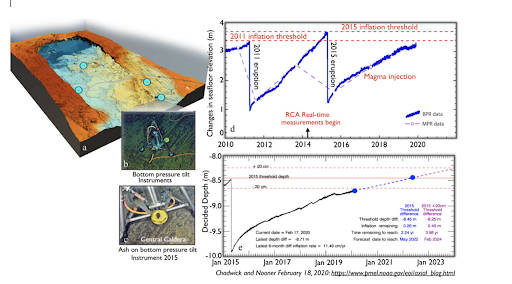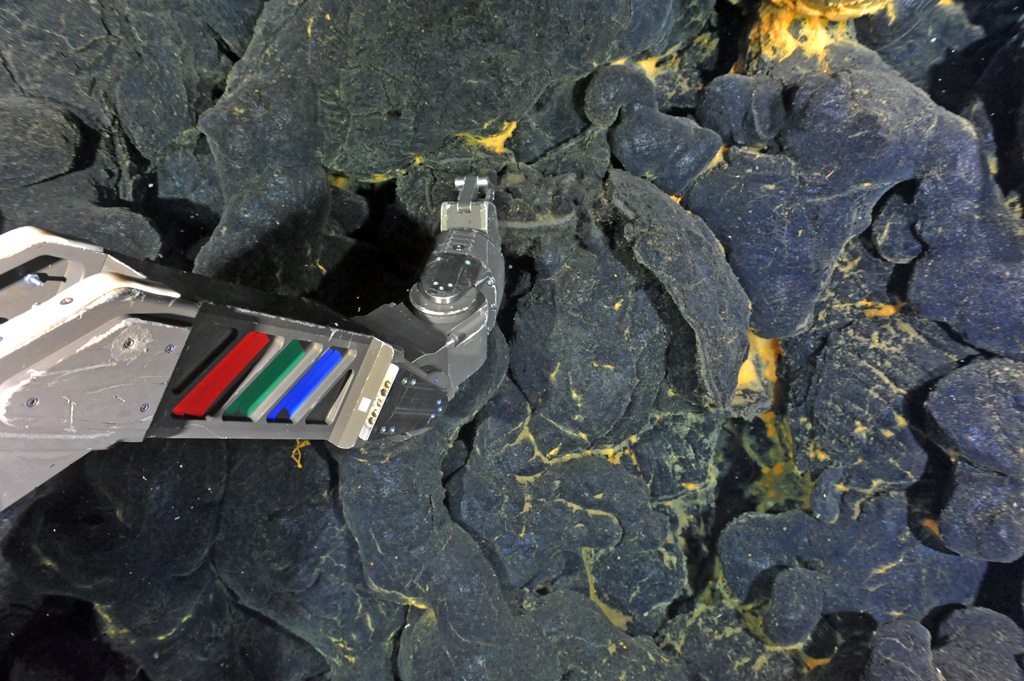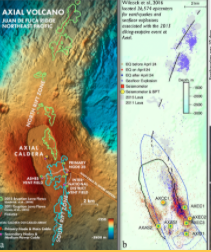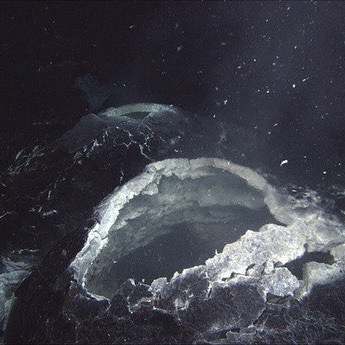Axial Seamount: First Volcano Where a Submarine Eruption May Be Predicted
Wilcock et al., 16 December 2016
Axial Seamount was chosen as a key site on the Regional Cabled Observatory because it is the most active volcano on the Juan de Fuca Ridge having erupted in 1998, 2011, and 2015 [1-7] and because it has a long history of observations as the site of the first submarine volcanic observatory “NeMO” [1-2; https://www.pmel.noaa.gov/eoi/nemo/index.html]. Axial is also unique because the structure of microbial communities has been examined for over 2 decades, including prior to and immediately following the eruptions [8-11]. Nearly continuous seafloor deformation measurements began in 1998 using battery-powered bottom pressure recorders (BPR’s), augmented by mobile pressure recorders in 2000 [3,12-14]. In 2014, an array of cabled bottom pressure tilt instruments, developed by Chadwick [13,14], were installed within the caldera providing real-time measurements of seafloor inflation caused by magma injection in the subsurface and extremely rapid deflation events coincident with eruptions and draining of the magma chamber [13,14]. In concert, these measurements, coupled with modeling, provide forecasting of when the next eruption may occur [13,14; https://www.pmel.noaa.gov/eoi/axial_blog.html].
The ability to make such forecasts is rare in both terrestrial and submarine environments, however, they are possible at Axial due to the continuous magma supply from the Cobb hotspot plume [12-14]. The subsurface structure of Axial is the best imaged submarine volcano due to multiple seismic imaging programs. In concert, these field programs have resulted in 3-D tomographic imaging of the magmatic system [15-20], providing unparalleled insights into melt distribution and magma flux, which controls seafloor deformation. Two large magma bodies at 1.1 to 2.6 km beneath the seafloor [15-18] and a newly recognized deep 3-5 km wide conduit located 6 km beneath the seafloor have been imaged [18]. The conduit is interpreted to contain a series of stacked melt lenses (sills) with spacings of 300-450 meters, providing melt transport that activated the eruptions in 1998, 2011, and 2015 [18]. The 22-year monitoring of Axial Seamount by Chadwick and Nooner document co-eruption deflation events in the caldera of 2.5-3.2 meters, followed by variable periods of inflation [14]. Based on the long-term time series, the 2015 eruption was forecast within a 1-year time window, seven months in advance of the eruption [14]. Daily updates are provided by the model, and coupled with real-time seismic measurements [e.g. 21], will allow refinement of when the next eruption will occur.
[blockquote][1] Embley Jr., R.W., Chadwick, W.W., Clague, D., and Stakes, D., (1999) The 1998 Eruption of Axial Volcano: multibeam anomalies and seafloor observations. Geophysical Research Letters, 26, 2428– 3425.
[2] Embley, R.W., Baker, E.T., (1999) Interdisciplinary group explores seafloor eruption with remotely operated vehicle. Eos Trans. AGU, 80, 213, 219, 222.
[3] Chadwick, W.W., Jr., Nooner, S.L. Zumberge, M.A.. Embley, R.W., Fox, C.G. (2006) Vertical deformation monitoring at Axial Seamount since its 1998 eruption using deep-sea pressure sensors. Journal of Volcanology and Geothermal Research, 150, 323-327.
[4] Chadwick, W.W., Jr., Paduan, J.B., Clague, D.A., Dreyer, B.M., Merle, S.G. Bobbitt, A.M. Bobbitt, Caress, D.W. Caress, Philip, B.T., Kelley, D.S., and Nooner, S. (2016) Voluminous eruption from a zoned magma body after an increase in supply rate at Axial Seamount. Geophysical Research Letters, 43, 12,063-12,070; https://doi.org/10.1002/2016GL071327.
[5] Caress, D. W., Clague, D. A. Paduan, J. B., Martin, J. F., Dreyer, B. M., Chadwick, W.W., Jr., Denny, A., and Kelley, D.S. (2012) Repeat bathymetric surveys at 1-metre resolution of lava flows erupted at Axial Seamount in April 2011. Nature Geoscience, 5(7), 483–488.
[6] Clague, D.A., Dryer, B.M., Paduan, J.B., Martin, J.F., Chadwick, W.W., Caress, D.W., Portner, R.A., Guilderson, T.P., McGann, M.L., Thomas, H., Butterfield, D.A., Embley, R.W. (2013) Geolgoica history of the summit of Axial Seamount, Juan de Fuca Ridge. Geochemistry Geophysics Geosystems, 14 (10), https://doi.org/10.1002/ggge.20240.
[7] Clague, D.A., Paduan, J.B., Caress, D.W., Chadwick, W.W., Jr., Le Saout, M., Dreyer, B.M. and Portner, R.A. (2017) High-resolution AUV mapping and targeted ROV observations of three historic lava flows at Axial Seamount. Oceanography, 30(4), 82–99; https://doi.org/10.5670/oceanog.2017.426.
[8] Huber, J.A., Butterfield, D.A., and Baross, J.A. (2003) Bacterial diversity in asubseafloor habitiat following a deep-sea volcanic eruption. FEMS Microbiology Ecology, 43, 393-409.
[9] Opatkiewicz, A.D., Butt4erfield, D.A., and Baross, J.A. (2009) Individual hydrothermal vents at Axial Seamount harbor distinct subseafloor microbial communities. FEMS Microbiology Ecology, 70, 413-424. https://doi.org/10.1111/j.1574-6941.2009.0074.x.
[10] Meyer, J.L., Akerman, N.H., Proskurowski, G., and Huber, J.A. (2013) Microbial characterization of post-eruption “snowblower” vents at Axial Seamount, Juan de Fuca Ridge. Frontiers in Microbiology, doi.org/10.3389/fmicb.2013.00153.
[11] Spietz, R.L., Butterfield, D.A., Buck, N.J., Larson, B.L., Chadwick, W.W., Jr., Walker, S.L., Kelley, D.S. and Morris, R.M. (2018) Deep-sea volcanic eruptions create unique chemical and biological linkages between the subsurface lithosphere and the oceanic hydrosphere. Oceanography, 31, 128-135; doi.org/10.5670/oceanog.2018.120.
[12] Nooner, S.L., and Chadwick, W.W., Jr., (2009) Volcanic inflation measured in the caldera of Axial Seamount: Implications for magma supply and future eruptions. Geochemistry, Geophysics, Geosystems, 10(2), doi.org/10.1029/2008GC002315.
[13] Nooner, S.L., and Chadwick, W.W. Jr. (2016) Inflation- predictable behavior and co-eruption deformation at Axial Seamount. Science, 354, 1399-1403; https://science.sciencemag.org/content/354/6318/1399
[14] Chadwick, W.W., Jr., Nooner, S.L., and Lau, T.K.A. (2019) Forecasting the next eruption at Axial Seamount based on an inflation-predictable pattern of deformation. American Geophysical Union, Fall Meeting 2019, OS51B-1489.
[15] Arnulf, A. F., Harding, A. J., Kent, G. M., Carbotte, S. M., Canales, J. P., and Nedimovic, M. R. (2014) Anatomy of an active submarine volcano. Geology, 42(8), 655–658. https://doi.org/10.1130/G35629.1
[16] Arnulf, A.F., Harding, A.J., Kent, G.M., and Wilcock, W.S.D. (2018) Structure, seismicity and accretionary processes at the hot-spot influenced Axial Seamount on the Juan de Fuca Ridge. Journal of Geophysical Research, 10.1029/2017JB015131.
[17] Carbotte, S. M., Nedimovic, M. R., Canales, J. P., Kent, G. M., Harding, A. J., and Marjanovic, M. (2008) Variable crustal structure along the Juan de Fuca Ridge: Influence of on-axis hot spots and absolute plate motions. Geochemistry, Geophysics, Geosystems, 9, Q08001. doi.org/10.1029/2007GC001922.
[18] Carbotte, S.M., Arnulf, A., Spiegelman, M., Lee, M., Harding, A., Kent, G., Canales, J.P., and Nedimovic, M., Stacked sills forming a deep melt-mush feeder conduit beneath Axial Seamount. Geology, 48, (7) 693-697. https://doi.org/10.1130/G47223.1.
[19] West, M., Menke, W., and Tolstoy, M. (2003) Focused magma supply at the intersection of the Cobb hotspot and the Juan de Fuca ridge. Geophysical Research Letters, 30(14), 1724. https://doi.org/10.1029/2003GL017104.
[20] West, M., Menke, W., Tolstoy, M., Webb, S., and Sohn, R. (2001). Magma storage beneath Axial volcano on the Juan de Fuca mid-ocean ridge. Nature, 413(6858), 833–836. doi.org/10.1038/35101581.
[21] Wilcock, W.S.D., Tolstoy, M., Waldhauser, F., Garcia, C., Tan, Y.J., Bohnenstiehl, D.R., Caplan-Auerbach, J., Dziak, R., Arnulf, A.F., and Mann, M.E. (2016) Seismic constraints on caldera dynamics from the 2015 Axial Seamount eruption. Science, 354, 1395-399;
https://doi org/10.1126 /science.aah5563.
[/blockquote] Read More
OOI Team First to See April 24, 2015 Eruption of Axial Seamount
At 7:33 p.m. PST on July 26th, 2015, after descending ~1840 m beneath the oceans surface, the remotely operated vehicle ROPOS and the University of Washington OOI Cabled Array team set first eyes on the April 24th, 2015 voluminous eruption of Axial Seamount during the VISIONS’ 15 cruise.
Read MoreAxial Eruption Site Identified – Bathymetric Survey Data Available Online
On April 24th, 2015, the Axial Volcano, situated on the Juan de Fuca plate 300 miles offshore, erupted one-mile deep in the ocean and we saw it.
Read MoreFollowing the Eruption and Evolution of a Submarine Volcano Live
An outstanding RCA science success has been the unprecedented insights into submarine volcanism (which accounts for >70% of the volcanism on Earth) through cabled instrumentation at Axial Seamount [1-5; 10-22].
Read MoreNew Research to Help Scientists Better Predict Underwater Volcanic Eruptions
A team of scientists studying last year’s eruption of Axial Seamount now says that the undersea volcano some 250 miles off the Oregon coast gave off clear signals hours before the eruption.
Read More




